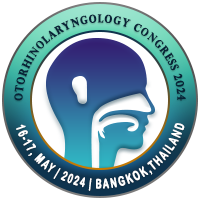
Yi-Ho Young
National Taiwan University Hospital, Taipei, TaiwanTitle: Development of vestibular-evoked myogenic potential in early life
Abstract
By way of loud sound or bone vibration stimulation, the vestibular-evoked myogenic potential (VEMP) can be recorded on the contracted neck muscles, called cervical VEMP (cVEMP), and on extraocular muscles, termed ocular VEMP (oVEMP). These two tests are recently adopted to assess the development of the sacculo-collic reflex and otolithic-ocular reflex system during early life, respectively.
Since the cVEMP is an inhibitory response, a clearly defined response can be recorded from neck muscles contraction. However, neck muscle of a newborn is not sufficient to be activated via head elevation. Alternative, head rotation method may help solve this problem (Ear Hear, 2006). To elicit cVEMPs in newborns, have the newborns rotate the head sideways toward one shoulder, with the head down on the yaw plane accompanied by rooting reflex to tense neck muscle (Audiol Neurotol, 2007). The EMG level feedback window simultaneously demonstrates background muscle activity, which is generally maintained at > 20 ?V in newborns (Clin Neurophysiol, 2007), and >50 ?V in children aged > 3 years (Clin Neurophysiol, 2012).
Unlike the cVEMP is an inhibitory potential correlated with the neck muscle activity, the oVEMP is an excitatory response of extraocular muscles. Since the inferior oblique muscle is the most superficial extraocular muscle that transverses the electrode recording site especially during upward gaze, oVEMPs are therefore obtained from the skin surface beneath the eyes. Nevertheless, small children have difficulty in maintaining an upward gaze (Int J Pediatr Otolaryngol, 2015). Alternatively, oVEMPs can be recorded by eyes closure in small children who cannot gaze upward (Clin Neurophysiol, 2012). With eyes closure, clear oVEMPs are elicited in children aged 2-3 years, but not in those aged < 24 months, indicating that the otolithic-ocular reflex has not yet matured at 2 years of age. In other words, oVEMP cannot be elicited in children until aged >2 years who can walk with a gait resembling that of an adult. Restated, oVEMP is tied to walking (Laryngoscope, 2013).
Clinically, etiology of vertigo/dizziness in children could be comprehensively investigated using an inner ear test battery comprising audiometry, cVEMP test, oVEMP test, and caloric test (Acta Otoalryngol, 2022). Both cVEMP and oVEMP could be successfully elicited in children aged < 3 years, and functional development of the otolithic system in growing children is thus determined.
Biography
Dr. Yi-Ho Young, is currently a full-time professor at the Department of Otolaryngology, National Taiwan University Hospital. He received his MD degree at the National Taiwan University in 1981, and PhD degree at the University of Tokyo in 1991. He has directed all his effort on extensive experiments especially the vestibular evoked myogenic potential (VEMP) study in humans (from newborn to the elderly) and animals.

